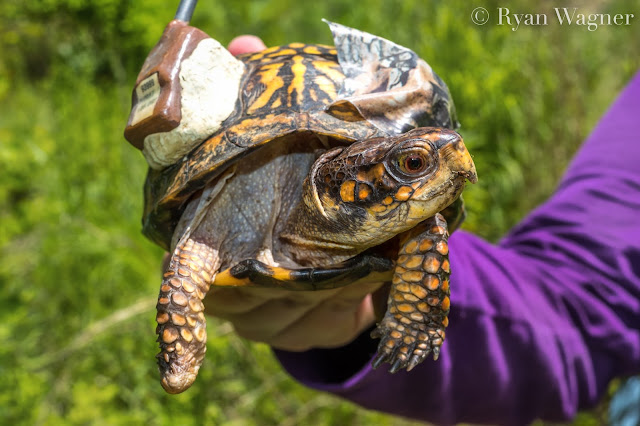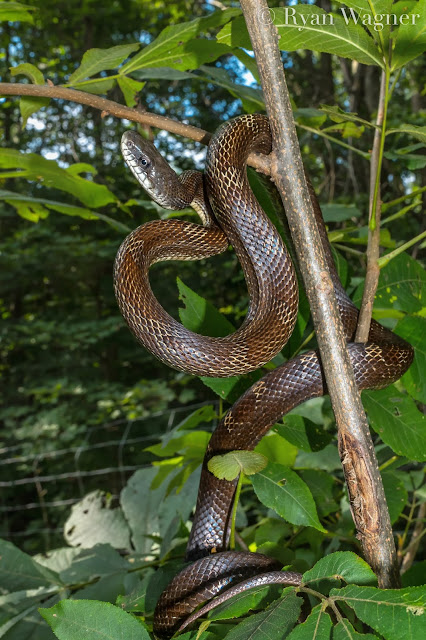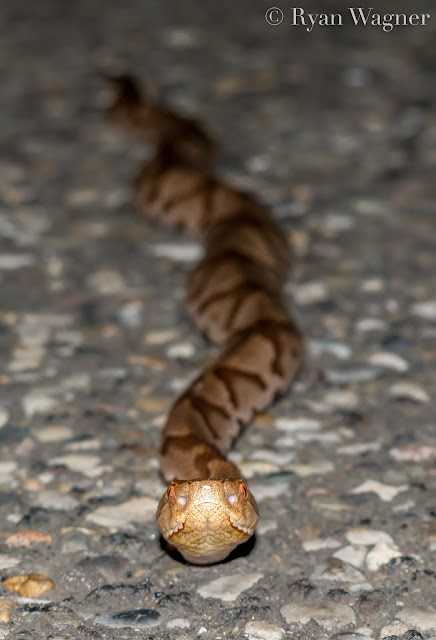Read part one HERE
As the weeks began to fly by, our little team of turtle researchers fell into a steady routine—or at least that’s what I would like to say. Rather, each day brought new and unexpected hurdles and challenges. “Adapt” quickly became the title of our project as we prepared ourselves for each new obstacle. Mosquitos swarmed, turtles went AWOL, we contended with ticks and chiggers and horseflies, one of our 30 turtles came down with a serious upper respiratory infection (at first we feared it was the deadly Ranavirus, which could wipe out our entire population), equipment failed, and weather scorched our necks and drenched our boots (often within the span of just a few minutes).
As the weeks began to fly by, our little team of turtle researchers fell into a steady routine—or at least that’s what I would like to say. Rather, each day brought new and unexpected hurdles and challenges. “Adapt” quickly became the title of our project as we prepared ourselves for each new obstacle. Mosquitos swarmed, turtles went AWOL, we contended with ticks and chiggers and horseflies, one of our 30 turtles came down with a serious upper respiratory infection (at first we feared it was the deadly Ranavirus, which could wipe out our entire population), equipment failed, and weather scorched our necks and drenched our boots (often within the span of just a few minutes).
Throughout it all, we remained positive and optimistic. After each grueling day in the heat and sun, Marcel and I often reflected on how lucky we were to be doing what we loved. Each day brought the anticipation of finding something new: a coiled snake beneath cover or a young fawn spooked from its unseen hiding place. We found immense beauty in the roadside groves and backwoods trails of our study sites. We weren't trapped in the confines of an office; we were out experiencing life—not only our lives, but the lives of our turtles.
Over the past several months, I have spent more time with these little cold-blooded, slow-moving, red-eyed, shell-toting, parrot-beaked, elephant-footed, scaly-skinned, mushroom-feasting creatures than I have with my own family. The turtles' hardships became our hardships. Their treks, our treks. Their ailments, our ailments. We struggled to remain detached and technical as the little round reptiles quickly stole our hearts. They were both our companions and our study subjects. Two conflicting states existing at once. Schrodinger’s turtle.
Turtle lesson number one: you cannot predict a turtle’s behavior. Naturally, we tried. Our initial labeling of turtle etiquette often coincided with gender. “Oh, this female must have traveled here to lay eggs,” or “That male probably is searching for a mate—or maybe new territory.” But these textbook explanations left us unsatisfied and missing the bigger picture. In many instances, the turtles’ behaviors didn't appear to be oriented towards sex or egg laying—nor even feeding, travel, or obvious thermoregulation. For all intents and purposes, one main activity appears to consume a box turtles' life. Doing nothing.
Obviously box turtles do things. They behave, they interact, they feed, breed, and live their turtle lives. The fact that we so often found them apparently “doing nothing” simply exposes the limits of our human perception. By our standards, a turtle sitting in the leaf litter is doing nothing. But a turtle doesn't care about human standards. To a turtle, its life is dynamic, fulfilled, chaotic, stressful, exciting, and unique. Doing nothing is something. The turtles chose to sit motionless in the leaf litter. Somehow, it must be a survival strategy. And it's working for them.
 Turtle researchers are a noisy and clumsy bunch. It is entirely possible that moments before the turtles noticed us they were behaving. Perhaps when they felt the vibrations of large bipedal apes lumbering, chatting, and snapping branches underfoot, they retreated into their shells and leafy forms (the shallow burrows box turtles dig with their front feet). Once we had finished our data collection and moved on, the turtles could return to their previous activities.
Turtle researchers are a noisy and clumsy bunch. It is entirely possible that moments before the turtles noticed us they were behaving. Perhaps when they felt the vibrations of large bipedal apes lumbering, chatting, and snapping branches underfoot, they retreated into their shells and leafy forms (the shallow burrows box turtles dig with their front feet). Once we had finished our data collection and moved on, the turtles could return to their previous activities.
I may be stepping brazenly close to anthropomorphizing box turtles, but that is a risk I take to understand them. They are individuals, self-aware and distinct. No two behave exactly alike. As scientists, however, we record the things we can see and quantify. So lets' talk about something we can see and quantify. The early stages of our research have shown that, while humans aren’t looking, box turtles do quite a lot. In particular, they are travelers.
 |
| Our female Stumpy is missing both her front and back feet on the right side of her body. Incredibly, she is able to move up and down the ravines just as much as any of our other turtles! |
There does not appear to be a single time of day when all box turtles move (although the literature suggests early mornings and evenings are when box turtles are on average most active due to lower temperatures). Movements seem to be up to each individual. One turtle moving through an area doesn't appear to have an effect on others in the vicinity. They come and go as they please. Weather does play a factor. Heavy rains cause many turtles to travel longer distances in a very short amount of time. But not all.
We rely on the turtles’ most recent “find points” to help us locate them quickly. Plotted on a GPS this allows us to locate the spot where we last saw each turtle. Sometimes this works. A turtle might occasionally hang out in the same general area for a few days, maybe a week, possibly even a month. Nearly all have eventually surprised us in one way or another. They shoot off in seemingly random and bizarre directions. They travel up and down ravines, from woods to field to woods again. Some have traveled over a mile in just a few weeks. I find myself trying to get inside these scaly creatures’ heads. What are they thinking? What makes them stay in one area and then travel somewhere identical or completely foreign at the drop of a hat? Do they have a plan? A set goal in mind? There must be some motivation behind their behaviors—evidence of instinct, or intelligence.
 |
| "The wild field tech in its natural habitat." Photo courtesy of Marcel Weigand. |
It is surprising that turtles travel so much each day, and yet we almost never find them actively moving. Not only do we find them not moving, but we often find them hunkered down in the leaf litter, half buried in their forms. This would suggest that the turtles hadn't simply stopped moving after detecting our approach. They weren't moving when we found them, and hadn't been moving for some time. North American box turtles are strictly diurnal, so their treks must be happening during the day. So why weren't we seeing them out walking across the forest floor? There were moments when it felt like some sort of cosmic prank. We were like children pondering the origin of the morning dew.
 |
| "Still life with Terrapene #TalkTurtlesToMe." Photo Courtesy of Marcel Weigand. |
For now, I will have to be content with not knowing. It is somehow comforting that even under such intensive observation these turtles can still keep so much of their lives a secret. We do science at the mercy of our study subjects. If the turtles refuse to reveal their true nature, there is nothing we can do but wait and watch. As animals go, reptiles often get a bad rap. They are rarely thought of as sophisticated, and yet, they have managed to outsmart us scientists on countless occasions. Turtles are humble creatures; they are even more humbling to work with.
 |
| "Best Olympic Dive of the day goes to ... #LeapinForLizards."" Photo courtesy of Marcel Weigand. |
My season as a turtle field technician is drawing to a close. I am heading back to school shortly and will be forced to leave the woods and fields behind (at least until the weekends). I have grown immensely as a young scientist, as has my appreciation for the natural world. I feel incredibly lucky to have been given a glimpse into the daily lives of box turtles. To get to know a wild creature so intimately is no small thing and something I will forever cherish.
 |
| Photo courtesy of Marcel Weigand. |
I will continue to work on the box turtle project throughout the year with Marcel, helping in the field whenever my schedule allows. I have a few more posts from this field season that I plan to write, in particular, the process behind testing our nail samples for corticosterone. If all goes according to plan I will be back out next season turtle hunting again. My endless thanks go to Marcel for being my mentor and friend, Dr. Popescu for welcoming me into his lab, my parents for their support and enthusiasm, and everyone else whom I have met and worked with this summer.
































